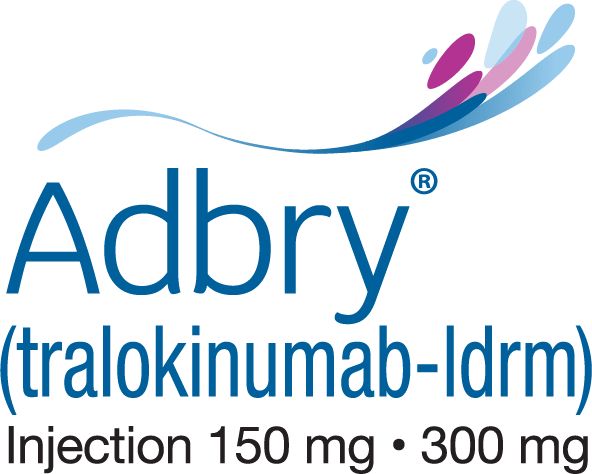References:
1. Davis DMR, et al. J Am Acad Dermatol. 2024:90(2):e43-e56. doi:10.1016/j.jaad.2023.08.102 2. AAAAI/ACAAI JTF Atopic Dermatitis Guideline Panel, et al. Ann Allergy Asthma Immunol. 2024;132(3):274-312. doi:10.1016/j.anai.2023.11.009 3. Data on file. LEO Pharma Inc. 4. Blauvelt A, et al. Continuous tralokinumab treatment over 4 years in adults with moderate-to-severe atopic dermatitis provides long-term disease control. Poster presented at: 32nd annual Congress of the European Academy of Dermatology and Venereology (EADV): October 11-14, 2023; Berlin, Germany. 5. Blauvelt A, et al. Long-term safety and efficacy of tralokinumab in adults and adolescents with moderate-to-severe atopic dermatitis treated for up to 6 years. Poster presented at: 44th Annual Fall Clinical Dermatology Congress: October 24-27, 2024; Las Vegas, NV. 6. ADBRY. Prescribing information. LEO Pharma Inc. 7. Reich K, et al. Safety of tralokinumab for the treatment of atopic dermatitis in patients with up to 4.5 years of treatment: an updated integrated analysis of eight clinical trials. Poster presented at: Revolutionizing Atopic Dermatitis (RAD) Conference; April 29-May 1, 2023; Washington, DC. 8. Bieber T. Allergy. 2020;75(1):54-62. doi:10.1111/all.13954 9. Tsoi LC, et al. J Invest Dermatol. 2019;139(7):1480-1489. doi:10.1016/j.jid.2018.12.018 10. Kim BE, et al. Clin Immunol. 2008;126(3):332-337. doi:10.1016/j.clim.2007.11.006 11. Szegedi K, et al. J Eur Acad Dermatol Venereol. 2015;29(11):2136-2144. doi:10.1111/jdv.13160 12. Popovic B, et al. J Mol Biol. 2017;429(2):208-219. doi:10.1016/j.jmb.2016.12.005 13. Wollenberg A, et al. Br J Dermatol. 2021;184(3):437-449. doi:10.1111/bjd.19574 14. Silverberg JI, et al. Br J Dermatol. 2021;184(3):450-463. doi:10.1111/bjd.19573 15. Simpson EL, et al. JAMA Dermatol. 2018;154(8):903-912. doi:10.1001/jamadermatol.2018.1572 16. Soung J, et al. Tralokinumab formulated as a pre-filled pen was efficacious and well-tolerated in adults and adolescents with moderate-to-severe atopic dermatitis. Poster presented at: Winter Clinical Dermatology Conference; February 16-19, 2024; Miami, FL. 17. Paller AS, et al. JAMA Dermatol. 2023;159(6):596-605. doi:10.1001/jamadermatol.2023.0627 18. Hanifin JM, et al. Exp Dermatol. 2001;10(1):11-18. doi:10.1034/j.1600-0625.2001.100102.x 19. Leshem YA, et al. Br J Dermatol. 2015;172(5):1353-1357. doi:10.1111/bjd.13662 20. Chopra R, et al. Br J Dermatol. 2017;177(5):1316-1321. doi:10.1111/bjd.15641 21. Futamura M, et al. J Am Acad Dermatol. 2016;74(2):288-294. doi:10.1016/j.jaad.2015.09.062 22. Phan NQ, et al. Acta Derm Venereol. 2012;92(5):502-507. doi:10.2340/00015555-1246 23. Silverberg JI, et al. Dermatol Clin. 2017;35(3):327-334. doi:10.1016/j.det.2017.02.005 24. Weidinger S, et al. Nat Rev Dis Primers. 2018;4(1):1. doi:10.1038/s41572-018-0001-z
